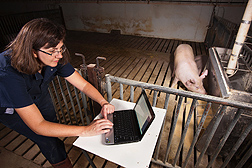Measuring the Feeding Behavior of Livestock
Determining how much time animals spend eating could help animal caretakers identify sick livestock, improve management, and establish genetic differences within a herd. But first, a system is needed to monitor animal feeding behavior.
Scientists at the Agricultural Research Service’s Roman L. Hruska U.S. Meat Animal Research Center in Clay Center, Nebraska, have developed a new system to monitor feeding behavior of feedlot cattle and grow-finish swine in a livestock industry setting.
The system, created by agricultural engineers Tami Brown-Brandl and Roger Eigenberg in the center’s Environmental Management Research Unit, uses standard radio-frequency identification technology designed around a commercial reader. The technology includes an ear tag applied to each animal, monitoring equipment at the feeders, and data recording and storage.
Eigenberg designed the hardware for the system, including a “multiplexer.” Instead of a single unit that connects to a single antenna, the multiplexer functions as multiple switches—connecting the signal from the reader to the correct antenna. Software designed by Brown-Brandl controls the hardware, timing, and data recording and storage.
“We can check antennas at a quick pace to determine if there is or isn’t an animal at each feeder space,” Brown-Brandl says. “This allows us to measure individual animal feeding behavior without influencing it. Once data is gathered and summarized, we can tell how much time each animal spent at the feeder.”
The system was originally designed for cattle and has been adapted to grow-finish swine. Antennas were encased in a PVC panel mounted on the front face of the standard swine feeders in 6 pens, each holding 40 pigs. Both systems were evaluated using video cameras and proved rugged and reliable.
“The relatively low-cost system has provided a wealth of feeding-behavior data,” says Brown-Brandl. “We’re reading every single antenna every 20 seconds in the swine area, and we are working on ways to summarize the data into information that could prove to be very useful for producers.”
The system will also provide valuable management information to aid in animal care. Scientists are working to determine the normal day-to-day variation in feeding behavior—time spent eating, number of eating events in a day, and timing of the events for each animal.
“If we could determine a pig’s normal eating behavior, we might be able to use this system to detect illness when a pig decreases its time spent eating,” Brown-Brandl says. “Sick pigs don’t always appear sick. If we could identify pigs as they become sick, we may be able to treat them earlier, preventing severe illness.”
Scientists are using the monitoring system’s data to examine feeding behavior as it relates to age, gender, weight gain, and health of animals. They also plan to determine the number of feeder spaces needed in each pen and whether additional feeder spaces would result in a more equal distribution of pig weights across the pen.—By Sandra Avant, Agricultural Research Service Information Staff.
This research is part of Food Animal Production, an ARS national program (#101) described at www.nps.ars.usda.gov.
Tami Brown-Brandl and Roger Eigenberg are in the USDA-ARS Environmental Research Unit, Roman L. Hruska U.S. Meat Animal Research Center, State Spur 18D, Clay Center, NE 68933; (402) 762-4279 [Brown-Brandl], (402) 762-4272 [Eigenberg].
"Measuring the Feeding Behavior of Livestock" was published in the July 2013 issue of Agricultural Research magazine.







